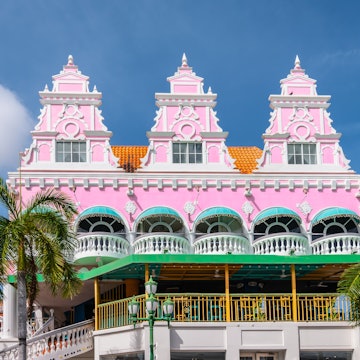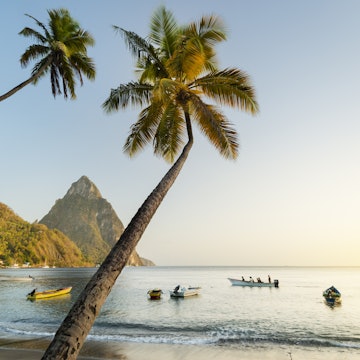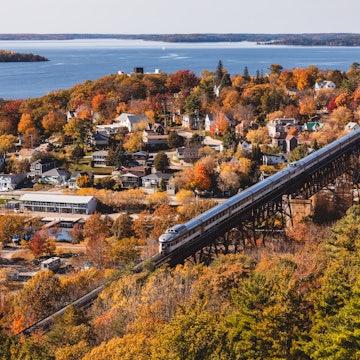

Petit-Champlain is one of Québec City’s most photogenic – and romantic – neighborhoods © littlenySTOCK / Shutterstock
Québec City is a capital city that has the vibe of a big, friendly village.
One of the most historic cities in North America, it’s best known for its peerless central district, Old Québec, filled with French- and English-built buildings from the 18th and 19th centuries, cobblestone streets and one of the most photographed hotels in the western hemisphere, the fabulous Château Frontenac.
But Québec City is about far more than old stones: the town fills up each summer thanks to lively music festivals and sporting events. In any given month, art installations and ephemeral urban spaces pop up throughout the city, while each summer the New France Festival shines a light on 17th-century Québec (known then as New France). In winter, Carnaval de Québec provides a welcome festive escape from the gray days of winter, as the snow-covered buildings and streets transform into a magical winter wonderland.
Rather than national and international chains, small, locally owned businesses predominate here, lending its streets even more charm and uniqueness. And the innovations of Québec City’s thriving restaurant scene rival those of much bigger Montréal.
It’s in Québec City’s lively neighborhoods that all this comes together. After you’ve taken in the impressive historic sites and oh-so-European vibe, stay longer to see how life is lived differently in this most special place.
These are the best neighborhoods in Québec City.

Vieux Québec (Upper Town)
Best neighborhood for sightseeing
The only European-built fortified city north of Mexico, Québec City has been a UNESCO World Heritage Site since 1985, with Upper Town the heart of Vieux Québec. Perched atop a cliff over the St Lawrence River, the Terrace Dufferin offers fabulous views of the historic streets stretching out below, and the tower of the Château Frontenac soaring up to the sky. Stop into Maison de la littérature, a French-language library built inside an old church, then stroll the old ramparts, complete with cannons, and admire the views from atop the old city gates.
Upper Town is an ideal place to stay. Hotels are generally modern-contemporary in style, with guesthouses in a more traditional Québécois style (think heavy woods and antiques). Hôtel Nomad and Monastère des Augustines are appealing options in this neighborhood.

Petit-Champlain (Lower Town)
Best neighborhood for finding a souvenir
Lower Town is an amalgam of two even smaller neighborhoods: Petit-Champlain and Place-Royale. Here, three-story, Normandy-style stone houses from the 18th century have colorful red, gray and blue sloped metal roofs that flank cobblestone streets. I love strolling down the narrow alley-like cobblestone streets in Petit-Champlain, buying artisanal food items, shoes and trinkets from boutiques run by Québec artisans.
The Breakneck Steps, tucked into the corner of Rue de la Petit-Champlain and Rue Sous le fort, offer a popular way to get between Lower and Upper towns. I have a love-hate relationship with these stairs, which are a tourist attraction. I love the view of Petit-Champlain from the top – but hate the slipperiness of the wooden stairs in winter.

Place-Royale (Lower Town)
Best neighborhood for people-watching
Place-Royale is home to the first trading post and settlement established by Samuel de Champlain in 1608. On this public square, you’ll find Église Notre-Dame des Victoires (which made an appearance at the end of Catch Me If You Can); gem and handicraft boutiques; and a choice of cafe and restaurant patios. Place-Royale is also the main site of the New France Festival each August. I love sitting on the steps of the church, sipping chocolat chaud and watching the crowds of tourists walking around, some with guides, and many with phones raised to snap pictures of the 300-year-old buildings.
At the junction of Rue St-Pierre and Rue Sous le Fort, the Royal Battery is a quiet place to relax under the shade of a tree. Down Rue St-Pierre is the site of the first woman-owned business in New France, which Marie-Anne Barbel operated from 1745 to 1748. Today, its stone vault is home to Pub l’Oncle Antoine, my favorite hang-out in the area. Order the French onion soup (it’s famous here) and a shot of maple whiskey while you enjoy the lively ambiance.

Vieux-Port
Best neighborhood for art and antiques
Part of historic Vieux Québec, Vieux-Port (Old Port) was once home to many of the city’s banks. Musée de la Civilisation is one of the city’s best, with a permanent exhibit highlighting Québec life, including that of its Indigenous peoples. You’ll find a plethora of art galleries and antique shops here, many in old bank buildings; each summer, the galleries in the neighborhood host an arts walk on Rue du Sault-au-Matelot.
Behind this main drag, the alley of wooden staircases and walkways called Rue Sous le Cap is my favorite way to avoid the summer crowds in summer. The street leads to the back door of a diner I recommend, Le Buffet de l’Antiquaire. In the 18th century, the waters of the St Lawrence licked the back of the houses here (which now face Rue du Sault-au-Matelot). Residents had to build sheds against the cliff as a protection, erecting walkways over the skinny street to connect the sheds with their homes. Today, it’s an alley where residents park – but the wooden walkways and stairs remain, a silent reminder of Québec City’s inescapable history.
St-Roch
Best neighborhood for food
St-Roch is the neighborhood I gravitate to when the tourist season is in full swing and I need to be with locals. Its closeness to Vieux Québec makes it easy to get to on foot, and it’s also home to some of my favorite restaurants and cafes. I love the vibrant and young ambiance of this part of Québec City.
St-Roch is home to microbreweries and some of the best restaurants in town, including award-winning Battuto and l’Affair est Ketchup. I can often be found at Café Saint-Henri micro-torréfacteur, which I love for its communal tables, rich chocolat chaud and fancy donuts. If I’m in the mood for cold brew, then I’m typing away from a table at Maelstrom, which turns into a cocktail bar at night. Clocher Penché is one of my favorite French bistros, while the cocktails at speakeasy JJacques are delightful. Nina Pizza Napolitaine is also a favorite indulgence.

St-Jean-Baptiste
Best neighborhood for a night out on the town
Follow Rue St-Jean past the old city gates and across Boulevard Honoré-Mercier to reach St-Jean-Baptiste and its cornucopia of shops, restaurants, bars and pubs.
Le Drague, the city’s best and oldest LGTBQI+ bar, is a club for everyone to enjoy. Sip drinks on the patio or dance from room to room inside. If you go on a weekend, you may catch a drag show. Pub Nelligan’s is a small Irish bar with exposed brick walls, wooden beams and an impressive selection of whiskey. I love Bar Le Sacrilège for its beer, live music and food partnerships with nearby restaurants. Le Projet, with its vaulted sculpted ceiling and delicious food menu, is another favorite.
Wherever you tipple, you’ll want to plan on a post-drinking poutine stop at Snack-bar Saint-Jean – which stays open until 4am.
Montcalm
Best neighborhood for arts and culture
Adjacent to the Plains of Abraham, where in an infamous 1759 battle the English defeated the French – kicking off centuries of resistance to anglicization in the province – the neighborhood of Montcalm is today a draw for culture lovers. Every summer, Festival d’été de Québec, one of Canada’s biggest music festivals, takes place on the lawns that occupy the former battlefield. This exciting event draws world-class acts – think Lady Gaga, Snoop Dogg, Three Days Grace and more.
Next to the Plains, the Musée National des Beaux-Arts de Québec (MNBAQ) exhibits works by famous artists from Québec and around the globe. The Grand Théâtre de Québec is a contemporary-style venue of concrete and glass offering opera, classical music and ballet, as well as contemporary musicians and comedians. On Grande-Allée and Ave Cartier, you’ll find restaurants and bars with busy summer patios – whether you’re headed to or from a cultural venue, or not.
















